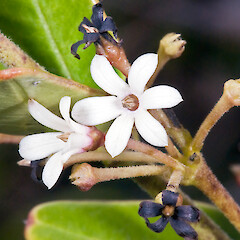Parsonsia praeruptis
Synonyms
None
Family
Apocynaceae
Flora category
Vascular – Native
Endemic taxon
Yes
Endemic genus
No
Endemic family
No
Structural class
Lianes & Related Trailing Plants - Dicotyledons
Chromosome number
2n = 18
Current conservation status
The conservation status of all known New Zealand vascular plant taxa at the rank of species and below were reassessed in 2017 using the New Zealand Threat Classification System (NZTCS) – more information about this can be found on the NZTCS website. This report includes a statistical summary and brief notes on changes since 2012 and replaces all previous NZTCS lists for vascular plants.
Please note, threat classifications are often suggested by authors when publications fall between NZTCS assessment periods – an interim threat classification status has not been assessed by the NZTCS panel.
- Conservation status of New Zealand indigenous vascular plants, 2017 . 2018. Peter J. de Lange, Jeremy R. Rolfe, John W. Barkla, Shannel P. Courtney, Paul D. Champion, Leon R. Perrie, Sarah M. Beadel, Kerry A. Ford, Ilse Breitwieser, Ines Schönberger, Rowan Hindmarsh-Walls, Peter B. Heenan and Kate Ladley. Department of Conservation. Source: NZTCS and licensed by DOC for reuse under the Creative Commons Attribution 4.0 International licence.
2017 | Threatened – Nationally Critical | Qualifiers: DP, OL, RF
Previous conservation statuses
2012 | Threatened – Nationally Endangered | Qualifiers: OL, RF
2009 | At Risk – Naturally Uncommon | Qualifiers: CD, OL
2004 | Range Restricted
Distribution
Endemic. New Zealand: North Island (Te Paki, where it is confined to the 120 ha exposure of ultramafic rocks at Hikurua / de Surville Cliffs and North Cape (Otou) (Heads & de Lange 1999)).
Habitat
An ultramafic endemic confined to low scrub, talus and boulderfield, and jointed and crevices within the exposed serpentinitic rocks and cliff faces of the Surville Cliffs area. It usually grows with Coprosma distantia, C. neglecta, Leucopogon xerampelinus and Carex ophiolithica.
Detailed description
Procumbent subshrub producing erect, stiff, unbranched, somewhat trailing, leafy stems 0.15–1.4 m long, 3 mm diameter. Stems sometimes rooting at nodes, never climbing or twinning, smooth, pale grey-brown. Internodes 10–50 mm long. Leaves yellowish-green, subcoriaceous, prophylls orbicular, 5 x 5 mm, usually present, subsequent leaves larger, variably shaped, oblong or ovate-triangular, not heterophyllous, petiole 1–2 mm long, leaf buttress geniculate below abscission zone, lamina 5–30 × 5–15 mm, leaf base truncate-subcordate, apex obtuse-subacute, usually truncate, mucronate, margin entire. Inflorescences axillary or terminal 25-flowered panicles. Flowers 5-merous, 4 mm long. Calyx lobes 1.5–2 mm, ovate. Corolla white, lobes 2–2.2 mm long, spreading, tube 2 mm long, rose-coloured. Follicles (fruits) 50–110 × 3–4 mm. Seeds 9 × 1.5 mm, coma 12 mm long.
Similar taxa
Parsonsia capsularis has been found growing sympatrically with P. praeruptis. Parsonia capsularis is similar but this is a larger climbing, twining vine, whose leaves though remarkably variable are never ovate with truncate bases. The flowers in P. capsularis have hairy calyx lobes, and longer peduncles and pedicels. P. capsularis as currently circumscribed comprises a number of distinct named varieties, several of which should probably be regarded as full species. Further research is needed.
Flowering
September–April
Flower colours
Cream, White
Fruiting
October–April
Propagation technique
Difficult. Does best in a free-draining, magnesium enriched soil within a pot. Seems to thrive when root-bound, and likes full sun.
Threats
A naturally uncommon species endemic to the 120-ha exposure of serpentinised peridotite rock known as the Surville Cliffs Formation. Here Parsonsia praeruptis is very common, however, it has been observed that possums selectively browse the fruits and flowers. For this reason, the conservation status of Parsonsia praeruptis changed from ‘At Risk-Naturally Uncommon’ to ‘Threatened-Nationally Endangered’ in 2013 (de Lange et al. 2013).By 2017, further decline had been observed and the status changed again, to ‘Threatened Nationally Critical’ (de Lange et al. 2018).
Etymology
parsonsia: Named after James Parsons, 18th century London physician and botanical author
Where To Buy
Not commercially available
Attribution
Fact Sheet prepared by P.J. de Lange (1 August 2005). Description based on Heads & de Lange (1999).
References and further reading
de Lange PJ, Rolfe JR, Barkla JW, Courtney SP, Champion PD, Perrie LR, Beadel SM, Ford KA, Breitwieser I, Schönberger I, Hindmarsh-Walls R, Heenan PB, Ladley K. 2018. Conservation status of New Zealand indigenous vascular plants, 2017. New Zealand Threat Classification Series 22. Department of Conservation, Wellington, NZ. 82 p. https://www.doc.govt.nz/globalassets/documents/science-and-technical/nztcs22entire.pdf.
de Lange PJ, Rolfe JR, Champion PD, Courtney SP, Heenan PB, Barkla JW, Cameron EK, Norton DA, Hitchmough RA. 2013. Conservation status of New Zealand indigenous vascular plants, 2012. New Zealand Threat Classification Series 3. Department of Conservation, Wellington, NZ. 70 p. https://www.doc.govt.nz/globalassets/documents/science-and-technical/nztcs3entire.pdf.
Heads, MJ, de Lange PJ. 1999. Parsonsia praeruptis (Apocynaceae): a new threatened, ultramafic endemic from North Cape, New Zealand. New Zealand Journal of Botany 37(1): 1–6. https://doi.org/10.1080/0028825X.1999.9512607.
NZPCN Fact Sheet citation
Please cite as: de Lange, P.J. (Year at time of access): Parsonsia praeruptis Fact Sheet (content continuously updated). New Zealand Plant Conservation Network. https://www.nzpcn.org.nz/flora/species/parsonsia-praeruptis/ (Date website was queried)





